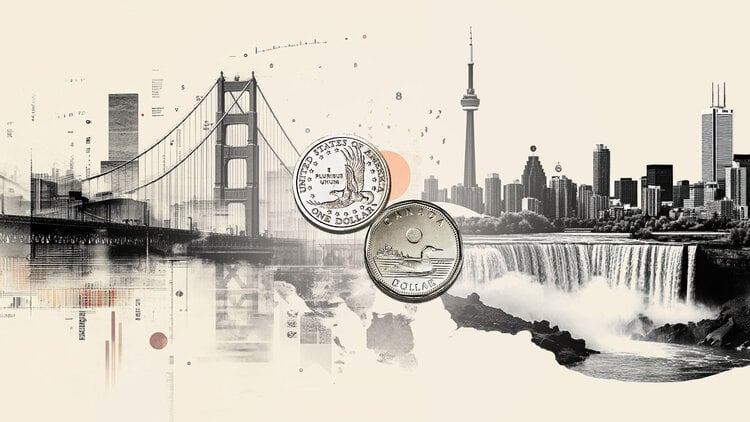- The Canadian Dollar middled on Tuesday, treading water in familiar territory.
- A mid-tier economic data docket this week has very few Canadian talking points.
- Global markets are waiting to see how the latest segment of the Trump tariff story unfolds.
The Canadian Dollar (CAD) stuck close to familiar levels on Tuesday, spinning a tight circle as investors take a breather following a sharp correction in forward expectations late last week. The US Dollar (USD) took a hard hit last Friday after US labor data faced sharp downside revision, and despite a sharp upstep in hopes for an impending rate cut from the Federal Reserve (Fed), recession fears are back on the rise.
Key US Services Purchasing Managers Index (PMI) figures missed the mark on Tuesday, adding further weight to concerns that the US economy may not be as hot as most expected through the first half of the year. Investor expectations are currently parked in a sweet spot where weakening economic data will force the Fed into fresh rate cuts, but remain firm enough that the US won’t backslide into an outright recession.
The Canadian data docket is largely empty this week, leaving Loonie traders in a lurch as trade and tariff headlines rule the roost. Canadian labor data is due on Friday, and is expected to show much of the same as the US’s latest net jobs numbers. Canadian Ivey PMIs for July are also expected on Thursday, but are unlikely to move the sentiment needle much.
Daily digest market movers: Canadian Dollar moves drop off as markets await structural shifts
- The Canadian Dollar is up 0.75% from last week’s 11-week low against the US Dollar.
- Greenback weakness has sparked a fresh bounce in Loonie flows after a near-term one-sided decline.
- US ISM Services PMI figures for July slumped to 50.1 on Tuesday, slumping back toward the 50.0 contraction level once again.
- The Canadian Ivey PMI for July is expected to tick up on Thursday, with median market forecasts anticipating a step up to 55.2 from 53.3.
- Canadian Net Change in Employment is also expected to drop off sharply, to 14.5K from 83.1K.
- The Canadian Unemployment Rate is also expected to tick up to 7.0% from 6.9%.

Canadian Dollar price forecast
The Canadian Dollar caught a headline-fueled break from one-sided US Dollar flows late last week, capping off a sharp turnaround in USD/CAD momentum. The Loonie has pared away some of the Greenback’s recent gains, pushing the pair back below the 1.3800 handle, but USD/CAD remains caught in a technical trap between the 50-day and 200-day Exponential Moving Averages (EMA) near 1.3740 and 1.3860, respectively.
USD/CAD daily chart

Canadian Dollar FAQs
The key factors driving the Canadian Dollar (CAD) are the level of interest rates set by the Bank of Canada (BoC), the price of Oil, Canada’s largest export, the health of its economy, inflation and the Trade Balance, which is the difference between the value of Canada’s exports versus its imports. Other factors include market sentiment – whether investors are taking on more risky assets (risk-on) or seeking safe-havens (risk-off) – with risk-on being CAD-positive. As its largest trading partner, the health of the US economy is also a key factor influencing the Canadian Dollar.
The Bank of Canada (BoC) has a significant influence on the Canadian Dollar by setting the level of interest rates that banks can lend to one another. This influences the level of interest rates for everyone. The main goal of the BoC is to maintain inflation at 1-3% by adjusting interest rates up or down. Relatively higher interest rates tend to be positive for the CAD. The Bank of Canada can also use quantitative easing and tightening to influence credit conditions, with the former CAD-negative and the latter CAD-positive.
The price of Oil is a key factor impacting the value of the Canadian Dollar. Petroleum is Canada’s biggest export, so Oil price tends to have an immediate impact on the CAD value. Generally, if Oil price rises CAD also goes up, as aggregate demand for the currency increases. The opposite is the case if the price of Oil falls. Higher Oil prices also tend to result in a greater likelihood of a positive Trade Balance, which is also supportive of the CAD.
While inflation had always traditionally been thought of as a negative factor for a currency since it lowers the value of money, the opposite has actually been the case in modern times with the relaxation of cross-border capital controls. Higher inflation tends to lead central banks to put up interest rates which attracts more capital inflows from global investors seeking a lucrative place to keep their money. This increases demand for the local currency, which in Canada’s case is the Canadian Dollar.
Macroeconomic data releases gauge the health of the economy and can have an impact on the Canadian Dollar. Indicators such as GDP, Manufacturing and Services PMIs, employment, and consumer sentiment surveys can all influence the direction of the CAD. A strong economy is good for the Canadian Dollar. Not only does it attract more foreign investment but it may encourage the Bank of Canada to put up interest rates, leading to a stronger currency. If economic data is weak, however, the CAD is likely to fall.

